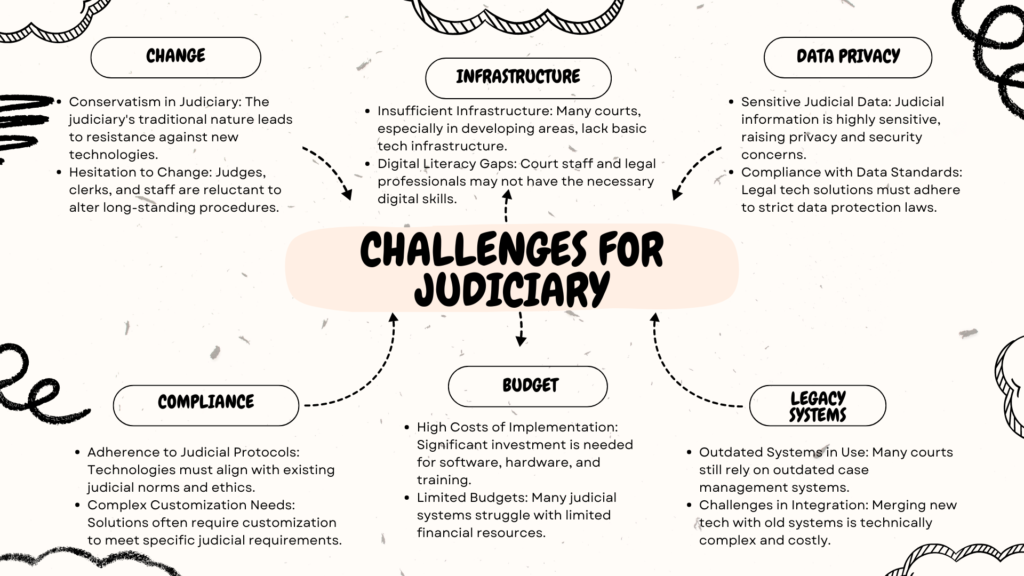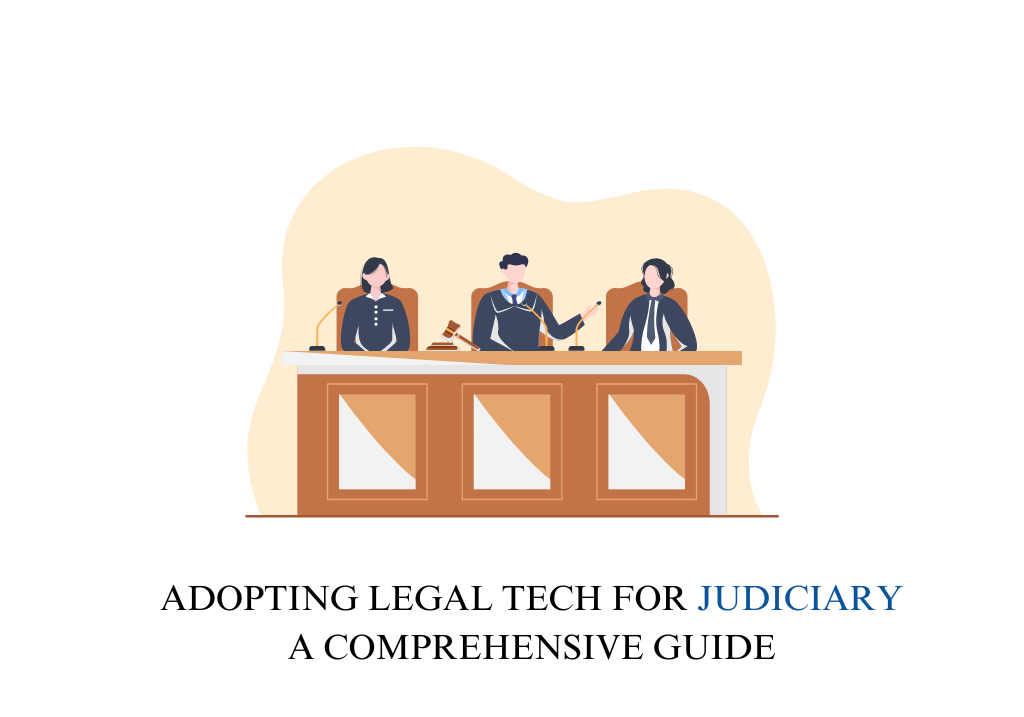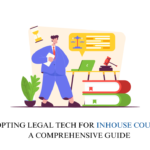Introduction
The judiciary is a cornerstone of governance, responsible for upholding the rule of law and ensuring justice is delivered fairly, efficiently, and transparently. However, the judiciary is often burdened with challenges such as case backlogs, slow processing times, complex litigation, and the need for extensive legal research. The integration of legal technology, or “legal tech,” offers a transformative opportunity to address these challenges and improve the administration of justice. Legal tech provides digital tools and solutions that can automate routine tasks, streamline case management, and enhance the overall efficiency and transparency of judicial processes. This article explores the importance of legal tech for the judiciary, identifies the key challenges faced by judicial systems, outlines a structured approach to adopting technology, and highlights the best legal tech tools for the judiciary.
Why Legal Tech for Judiciary?
Legal technology is not just a luxury; it is a necessity for modern judicial systems that aim to deliver timely and effective justice. Here are the key reasons why legal tech is essential for the judiciary:
- Improving Efficiency and Reducing Case Backlogs: One of the biggest challenges faced by judicial systems worldwide is the backlog of cases. Legal tech solutions can help automate repetitive tasks, streamline case management, and reduce administrative burdens, thereby accelerating the pace of justice.
- Enhancing Transparency and Accountability: Legal tech tools can ensure greater transparency in judicial processes by providing real-time access to case status, hearing schedules, and judicial orders. This transparency helps build public trust in the judiciary and enhances accountability.
- Facilitating Remote and Digital Court Proceedings: The COVID-19 pandemic highlighted the need for digital transformation in the judiciary. Legal tech enables remote court hearings, digital document submission, and virtual collaboration, ensuring the continuity of judicial processes even in challenging circumstances.
- Ensuring Consistency and Accuracy in Judgments: Advanced legal research tools and case law analytics can assist judges and clerks in quickly finding relevant precedents, statutes, and legal principles, ensuring consistency and accuracy in judgments.
- Managing Complex Litigation Efficiently: Legal tech provides tools for efficient management of complex litigation, including e-discovery, evidence management, and coordination among multiple parties. This reduces the time and resources required for lengthy trials.
- Improving Accessibility to Justice: By digitizing court processes and making information more accessible, legal tech ensures that justice is not only done but also seen to be done. This improves access to justice for all, including underserved and remote communities.
Challenges Faced by the Judiciary in Adopting Legal Tech
While the benefits of legal tech for the judiciary are clear, there are several challenges to its adoption:

Kickstarting the Legal Tech Journey for the Judiciary
Adopting legal technology in the judiciary requires a thoughtful, strategic approach to ensure successful implementation and sustainable impact. The following steps provide a comprehensive roadmap for judiciary systems to embark on their legal tech journey:
| Phase | Key Steps | Practical Insights |
| Phase 1: Strategic Assessment and Planning | – Conduct a Comprehensive Needs Assessment.- Develop a Legal Tech Roadmap and Strategy. | – Engage Stakeholders through workshops with judges, clerks, and IT staff to identify pain points.- Map Judicial Workflows to identify bottlenecks and inefficiencies.- Set Clear, Measurable Goals (e.g., 40% reduction in case backlogs). |
| Phase 2: Research and Solution Evaluation | – Identify and Evaluate Legal Tech Solutions.- Form an Evaluation Committee. | – Select Vendors with Judiciary Experience who prioritize security, compliance, and scalability.- Conduct Proof-of-Concept (POC) Trials involving end users to assess usability and integration.- Use a Structured Scoring System to evaluate solutions. |
| Phase 3: Pilot Testing and Customization | – Pilot Legal Tech Solutions in Select Courts.- Customize Solutions Based on Feedback. | – Choose High-Impact Courts for pilot testing (e.g., family or commercial courts).- Monitor KPIs such as time savings and user satisfaction.- Designate Technology Champions to advocate for new tools and provide support. |
| Phase 4: Full-Scale Implementation and Continuous Support | – Implement Technology Across All Courts.- Provide Continuous Learning and Support. | – Use a Phased Roll-Out approach to implement technology gradually and learn from each stage.- Ensure Secure Data Migration and prevent data loss or corruption.- Set Up a Dedicated Help Desk for ongoing user support. |
| Phase 5: Continuous Improvement and Innovation | – Scale Up and Integrate Additional Tools.- Stay Updated on Legal Tech Trends. | – Expand to Advanced Tools like predictive analytics and automated judgment drafting after core tools are implemented.- Integrate with Other Judicial Systems for seamless data sharing and collaboration.- Encourage Continuous Improvement through regular feedback and audits. |
Phase 1: Strategic Assessment and Planning
- Conduct a Comprehensive Needs Assessment
- Engage Key Stakeholders: Begin by organizing workshops and consultations with a broad range of stakeholders, including judges, clerks, court staff, lawyers, IT professionals, and administrative personnel. These sessions should aim to identify specific pain points, such as delays in case management, inefficient document handling, or challenges in scheduling hearings.
- Analyze Current Judicial Workflows: Map out the existing processes and workflows within the judiciary, from case filing to judgment delivery. This will help in understanding the bottlenecks and inefficiencies in current operations. For example, identify manual tasks that consume significant time, such as physical document filing or manual scheduling of court hearings.
- Set Clear, Measurable Goals: Establish specific objectives for adopting legal technology. These goals could include reducing case backlogs by 40%, cutting down the time taken for case scheduling by 50%, or ensuring 100% digital management of court records. Setting measurable goals provides a clear vision and direction for the technology adoption process.
- Develop a Legal Tech Roadmap and Strategy
- Create a Multi-Phase Legal Tech Roadmap: Design a strategic roadmap that outlines the phases of legal tech adoption. Start with foundational tools such as Electronic Case Management Systems (ECMS) and e-filing solutions that address immediate needs like case tracking and digital document management. Progress to more advanced tools like AI-driven legal research, virtual court hearing platforms, and evidence management systems as the judiciary becomes more technologically mature.
- Prioritize Legal Tech Investments: Based on the needs assessment, prioritize the legal tech tools that will have the most significant impact on judicial efficiency. For example, if document handling and case tracking are critical issues, prioritize investing in a comprehensive ECMS. If delays in legal research are a problem, consider AI-powered legal research tools as a priority.
- Allocate a Budget and Timeline: Develop a detailed budget that accounts for technology acquisition, infrastructure upgrades, training, and ongoing support. Establish a realistic timeline for each phase of implementation, ensuring there is room for piloting, feedback, and iterative improvements.
Phase 2: Research and Solution Evaluation
- Identify and Evaluate Legal Tech Solutions Suitable for Judicial Use
- Research Legal Tech Vendors Experienced in Serving the Judiciary: Look for vendors who have a proven track record of providing legal tech solutions specifically designed for judicial institutions. Ensure that these solutions offer robust features for security, compliance, data privacy, and integration with existing court systems.
- Assess Solutions for Scalability, Security, and Compliance: Given the sensitive nature of judicial data, it is crucial to choose legal tech solutions that comply with strict data protection standards. Evaluate each solution’s scalability to ensure it can handle growing volumes of cases, documents, and users.
- Request Product Demos and Conduct Proof-of-Concept Trials: Arrange for demonstrations and conduct proof-of-concept (POC) trials to evaluate how well potential solutions integrate with existing workflows. Engage end users—such as judges, clerks, and IT staff—in the POC process to gather insights on usability, functionality, and potential challenges.
- Engage Key Stakeholders and Form an Evaluation Committee
- Form a Cross-Functional Evaluation Committee: Assemble an evaluation committee consisting of judges, court clerks, IT professionals, legal advisors, and administrative staff. This team will be responsible for evaluating potential solutions from different perspectives and ensuring they meet both judicial and technical requirements.
- Develop Evaluation Criteria and Scoring Metrics: Establish clear evaluation criteria such as ease of use, integration capabilities, scalability, vendor support, total cost of ownership, and alignment with judicial norms. Use a structured scoring system to objectively assess each solution against these criteria.
- Gather Feedback from End Users During Trials: Collect feedback from judges, clerks, and other court staff during the POC trials. This feedback will be invaluable in understanding how well the solution fits within the current judicial ecosystem and where improvements might be needed.
Phase 3: Pilot Testing and Customization
- Pilot Legal Tech Solutions in Select Courts or Departments
- Choose High-Impact Courts or Departments for Piloting: Identify specific courts, departments, or judicial functions where the new technology can be piloted. For example, start with a pilot in a family court or a commercial court where document management and case scheduling are significant challenges.
- Monitor Key Performance Indicators (KPIs) During the Pilot: Track important KPIs such as time savings, case processing speed, error reduction, user adoption rates, and overall satisfaction during the pilot phase. Use these metrics to evaluate the effectiveness of the solution and identify areas for improvement.
- Customize the Solution Based on Feedback and Judicial Needs: Work with the vendor to fine-tune and customize the legal tech solution to better fit the judiciary’s unique needs. Customization may include configuring specific workflows, creating specialized templates, enhancing security protocols, or integrating with legacy systems.
- Establish a Change Management and Training Plan
- Develop a Comprehensive Change Management Strategy: Address resistance to change by communicating the benefits of legal tech adoption to all stakeholders. Highlight how technology will ease workloads, improve efficiency, and enhance transparency in judicial processes.
- Designate “Technology Champions”: Identify and train a group of “technology champions” within the judiciary who will advocate for the new tools, assist their peers, and provide ongoing feedback to the project team. These champions can be judges, clerks, or IT staff who are particularly tech-savvy and enthusiastic about the transformation.
- Create a Robust Training Program for Judges and Court Staff: Develop a detailed training plan that includes role-based training sessions tailored to different user groups. Judges may require more focused training on legal research and analytics tools, while clerks may need in-depth guidance on using e-filing and document management systems.
Phase 4: Full-Scale Implementation and Continuous Support
- Implement the Technology Across All Courts and Departments
- Roll Out Technology in a Phased Approach: Instead of a big-bang implementation, roll out the technology in phases, starting with departments or courts that are most prepared or have the most significant need for change. This phased approach allows for controlled implementation and learning from each phase.
- Ensure Secure and Seamless Data Migration: Work closely with IT teams and vendors to ensure the secure and accurate migration of data from legacy systems to new platforms. Conduct multiple rounds of testing to ensure data integrity and prevent any loss or corruption.
- Provide Comprehensive Training and Ongoing Learning Opportunities
- Offer Continuous Learning and Support Programs: Training should not be a one-time event. Offer continuous learning opportunities such as refresher courses, advanced workshops, webinars, and access to an online knowledge base. This ensures that all users stay updated on new features and best practices.
- Set Up a Dedicated Help Desk or Support Team: Create a help desk or support team within the judiciary to provide ongoing support to users. Ensure that users have access to both internal resources and vendor support to address any issues promptly.
- Monitor, Evaluate, and Optimize the Use of Legal Tech Solutions
- Track Key Performance Indicators (KPIs) and Collect Feedback: Continuously monitor KPIs such as user adoption rates, time saved, reduction in errors, and overall efficiency improvements. Conduct regular surveys and feedback sessions to gather user insights.
- Optimize Workflows and Expand Capabilities Based on Insights: Use the data collected to refine workflows, automate additional tasks, and improve the overall user experience. For example, if judges require more personalized research tools, consider integrating AI-driven legal research modules.
Phase 5: Continuous Improvement and Innovation
- Scale Up and Integrate Additional Legal Tech Tools
- Expand to More Advanced Tools and Features: After the successful implementation of core legal tech solutions, scale up to more advanced tools such as predictive analytics for case outcomes, automated judgment drafting, or machine learning for evidence analysis.
- Integrate Legal Tech with Other Judicial and Governmental Systems: Ensure that the legal tech solutions are integrated with other systems used within the judiciary or by other government agencies. This integration can enhance data sharing, improve collaboration, and streamline workflows.
- Stay Updated on Legal Tech Trends and Encourage Continuous Innovation
- Participate in Legal Tech Conferences and Webinars: Encourage judges, clerks, and court administrators to stay updated on the latest legal tech trends by attending industry conferences, webinars, and workshops.
- Foster a Culture of Continuous Improvement: Encourage a culture where judges, clerks, and court staff are continuously looking for ways to improve processes and suggest new technologies that could enhance judicial efficiency.
- Conduct Regular Reviews and Adjust the Strategy as Needed
- Schedule Periodic Technology Audits: Conduct regular audits to evaluate the performance of legal tech solutions, identify gaps, and make necessary adjustments to align with evolving judicial needs and goals.
Best Categories of Legal Tech for Judiciary
Based on the unique needs and challenges of the judiciary, the following categories of legal tech tools are most beneficial:
- Electronic Case Management Systems (ECMS)
- Why It’s Useful: ECMS allows courts to manage cases electronically, from filing to disposition. It includes features like e-filing, digital document management, scheduling, and case tracking, enabling efficient and transparent case management.
- Key Features: Real-time case updates, automated scheduling, digital document storage, user access control, and integration with existing court databases.
- AI-Powered Legal Research and Case Law Analytics
- Why It’s Useful: AI-driven legal research tools can significantly reduce the time judges and clerks spend finding relevant case law, statutes, and legal principles. These tools can provide insights into case outcomes based on historical data.
- Key Features: Natural language processing (NLP) for legal queries, citation analysis, case prediction analytics, and customizable research dashboards.
- E-Discovery and Evidence Management Platforms
- Why It’s Useful: E-discovery tools help manage and analyze large volumes of electronic evidence, ensuring that all relevant information is presented during litigation. These tools enhance the efficiency and accuracy of the discovery process.
- Key Features: Advanced search and filtering, data encryption, secure evidence storage, collaboration features, and integration with case management systems.
- Virtual Court Hearing Platforms
- Why It’s Useful: Virtual court platforms enable remote court proceedings, reducing the need for physical presence and ensuring continuity during emergencies or crises. They offer video conferencing, digital submission of documents, and real-time transcription services.
- Key Features: Secure video conferencing, document sharing, real-time transcription, digital evidence presentation, and integration with ECMS.
- Governance, Risk, and Compliance (GRC) Tools
- Why It’s Useful: GRC tools help judicial institutions monitor compliance with judicial norms, ethical standards, and procedural guidelines. They provide real-time alerts for non-compliance and facilitate internal audits.
- Key Features: Real-time compliance monitoring, audit trails, reporting dashboards, risk assessment modules, and role-based access control.
Conclusion
The adoption of legal technology in the judiciary is not just a step toward modernization; it is a critical move to enhance the efficiency, transparency, and accessibility of justice. While there are challenges in adopting legal tech, a well-planned and structured approach can help judicial institutions overcome these hurdles and realize the full potential of technology. By focusing on the right tools and ensuring continuous optimization, the judiciary can deliver faster, fairer, and more transparent justice to all.


